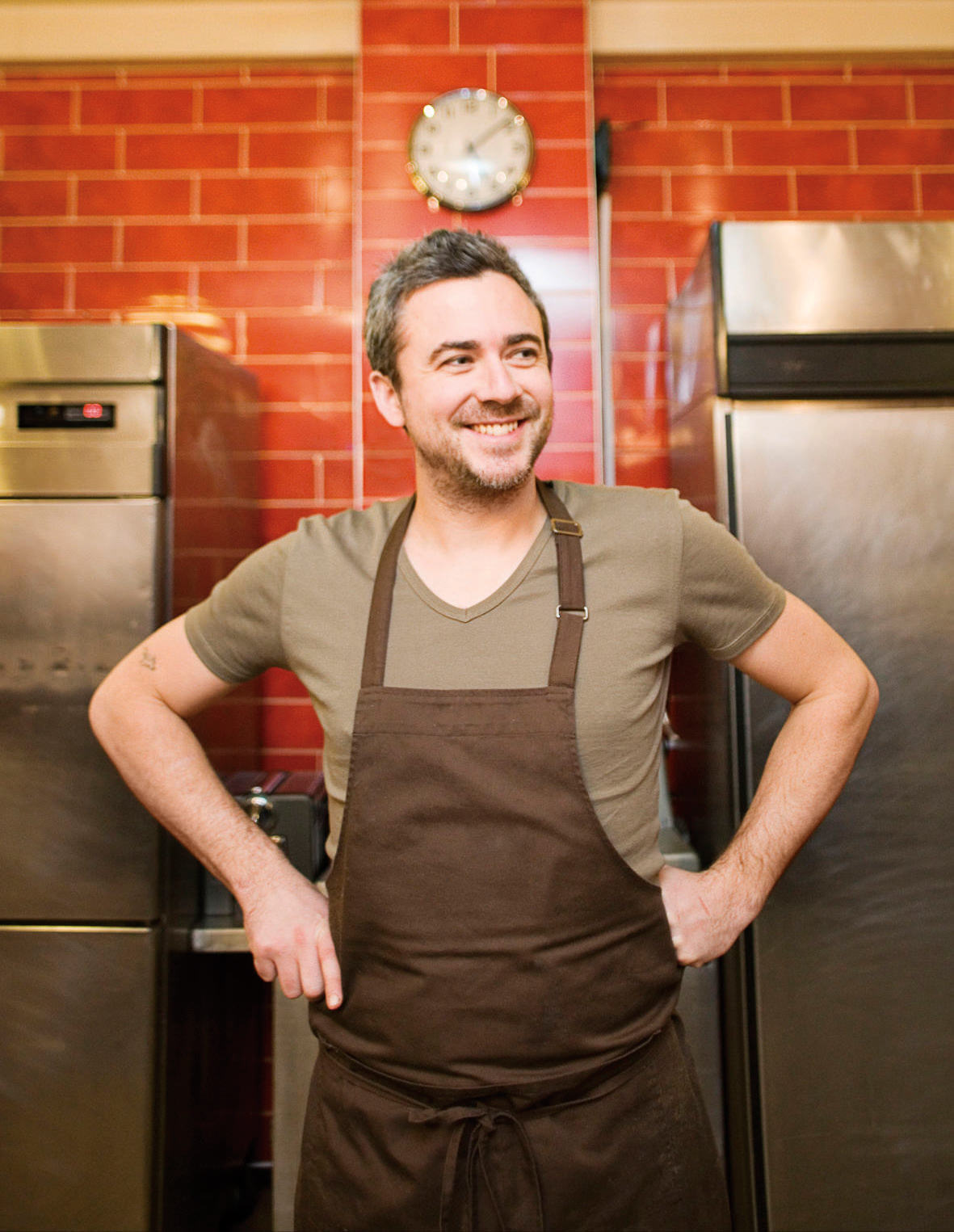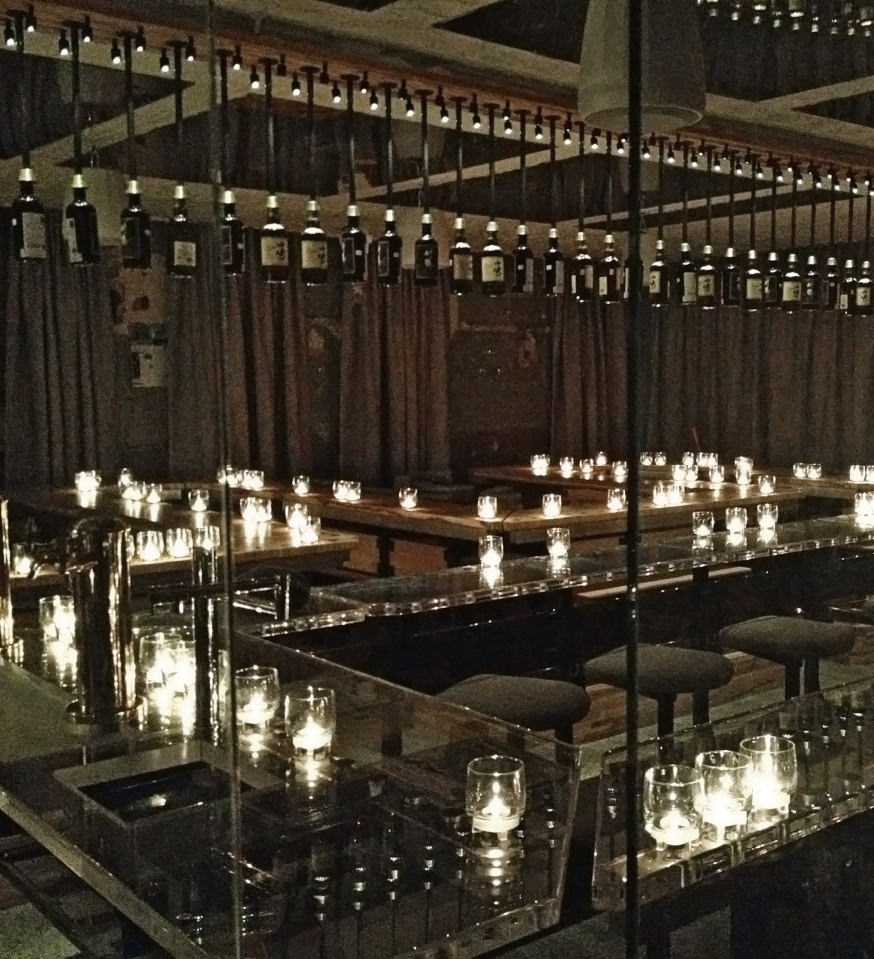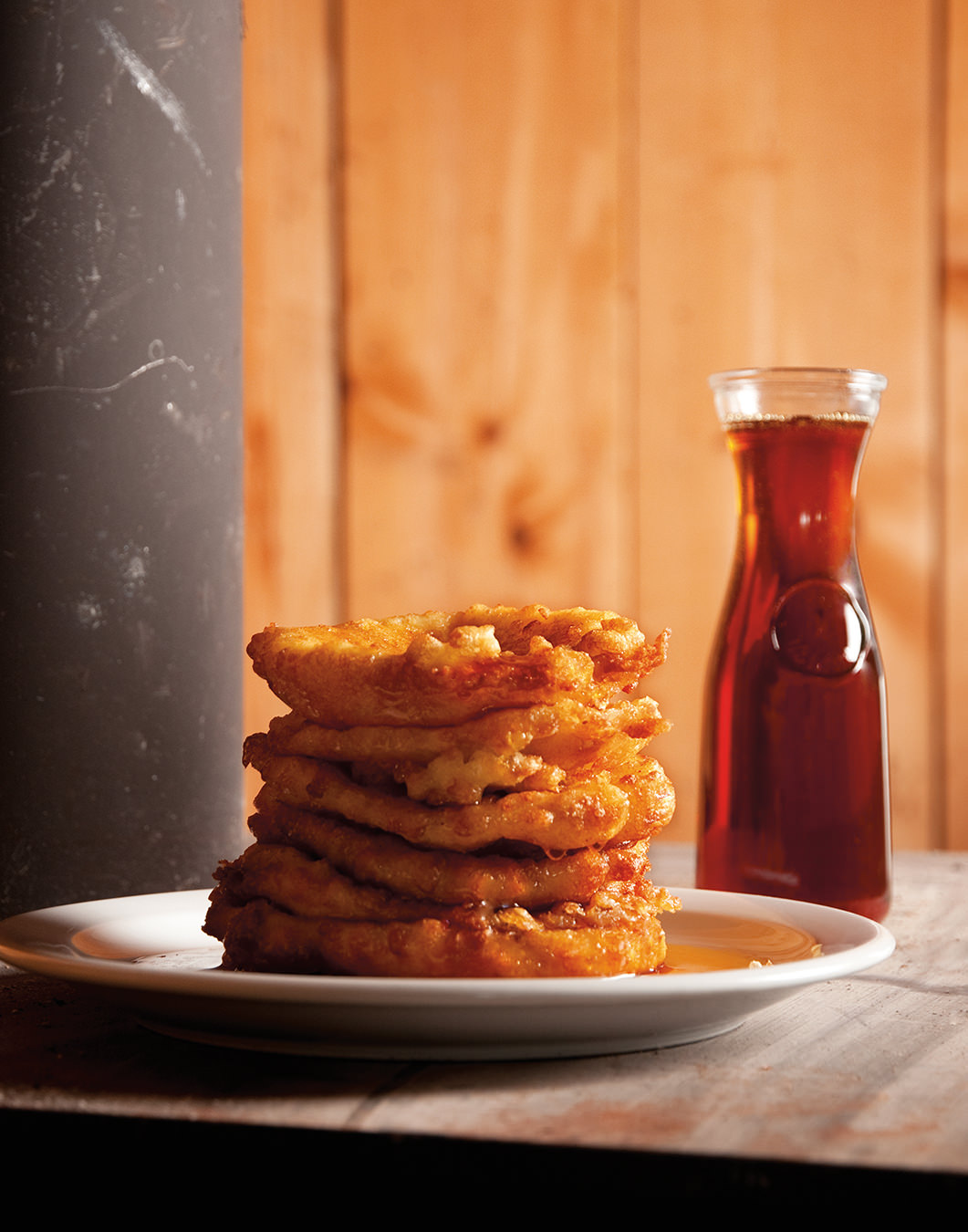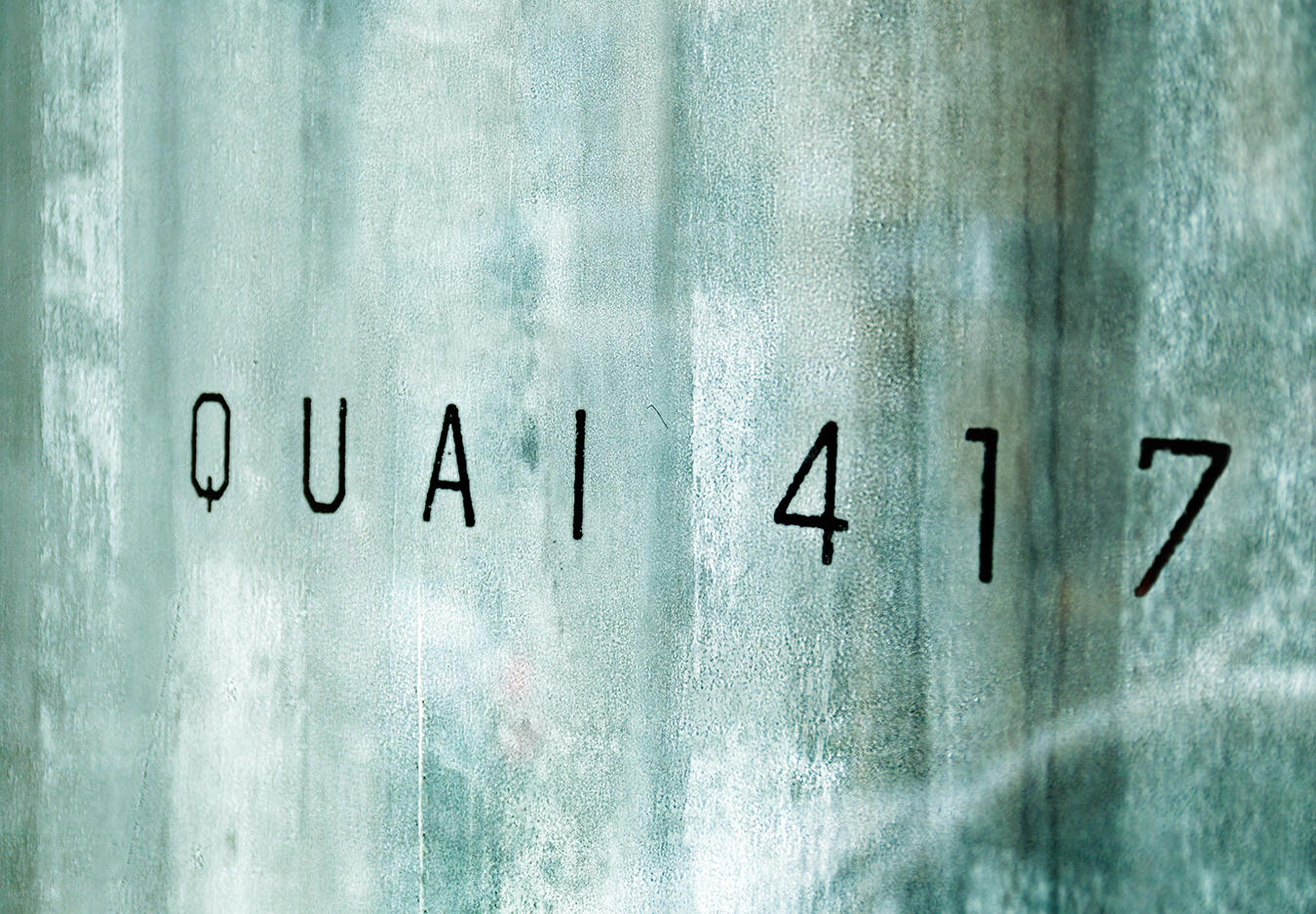Normand Latourelle
The horseman.
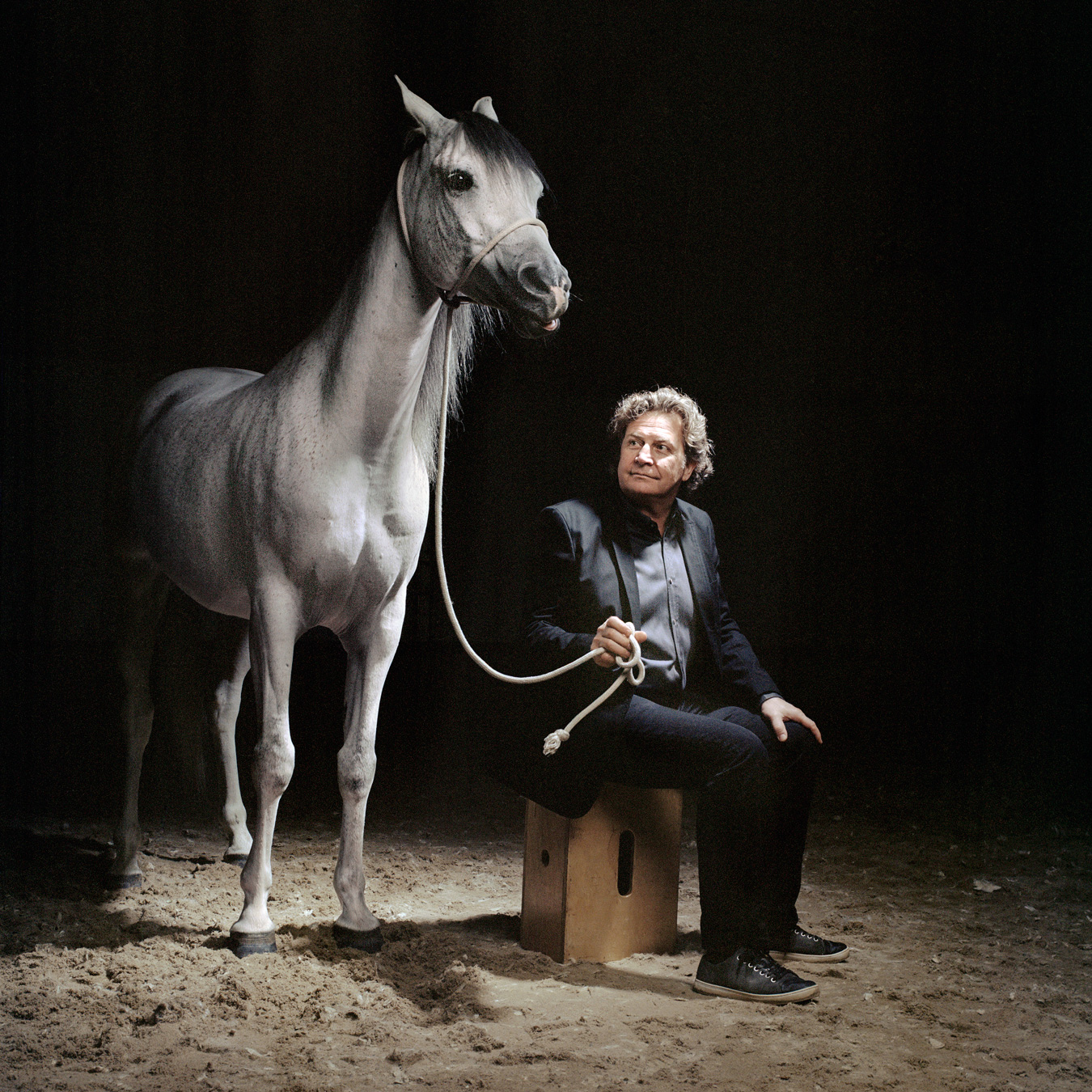
Normand Latourelle strides into one of the white tents anchored near the shores of Lake Ontario, where the members of his multinational equestrian spectacular, Odysseo, are having lunch. He is all smiles, even as he acknowledges that he can’t remember anyone’s name. “There are 500 people comfortably making a living here,” he says, nodding to the acrobats, riders, musicians, grooms, and riggers smiling right back at him. “It’s like a small town.”
If that’s the case, then Latourelle, an ebullient man 59 years young, is the town’s mayor. As creator and producer of the world’s largest touring show, Latourelle oversees the myriad departments responsible for making Odysseo a runaway success. A sequel to 2003’s Cavalia, the acclaimed multimedia production uses 70 horses, more than 45 skilled performers, and a rear-projection set design the size of three IMAX screens in presenting an uplifting vision of humans in choreographed step with nature.
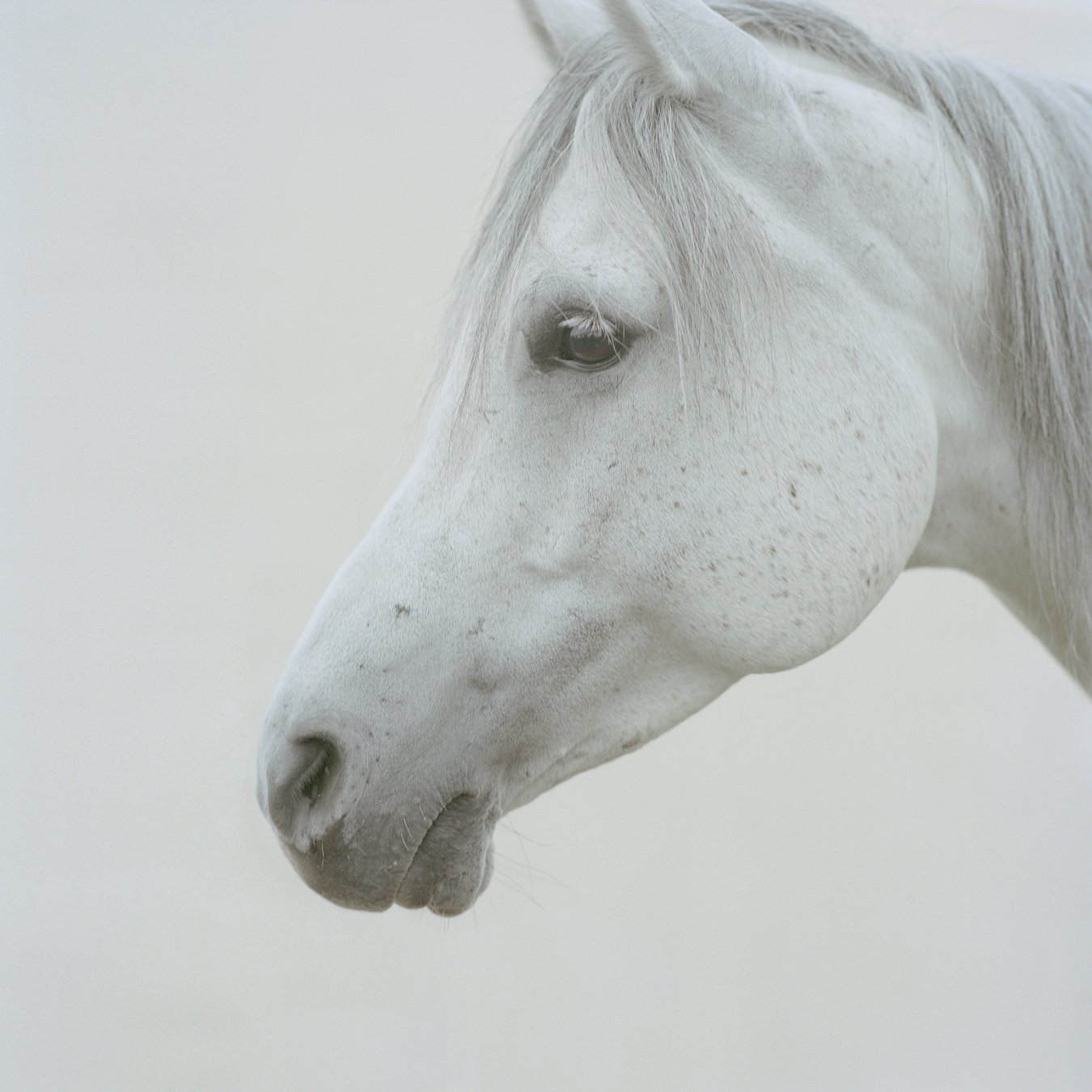
The acclaimed multimedia production uses 70 horses. Photo by Hudson Hayden.
The exquisitely directed horse ballet was first mounted in Quebec in 2011 and revised earlier this year on an even larger scale. It is presently on a North American tour that opened in Toronto in April and continues for a month of summer performances starting on June 17. Costing $35-million to create and another $40- to $45-million a year to maintain without the benefit of government grants, Odysseo is a tour de force which nightly packs 2,000 spectators into the seated theatre housed inside the series of large white tents the production brings with it wherever it goes. “I’m not a sophisticated intellectual. I have a very simple way of looking at things, and that’s reflected in my show,” says Latourelle, describing what he thinks is Odysseo’s appeal. “It’s not a simple show, but the message is simple to read. You don’t have to think too deeply about the story. You just have to let yourself go.”
Odysseo has as its title a word that means a long journey filled with adventures. It has grown out of Latourelle’s own peripatetic quest for personal meaning. A horseman neither by nature or design, Latourelle is a self-confessed urbanite who regards the hoofed beasts who are the undisputed stars of his show as embodying freedom, a world without limits. “I have never thought about money,” says the impresario with a mane of curly hair as he nurses a coffee. “For me, it has always been about pushing the limits, trying always to do better and to be different. I always wanted to be different.”
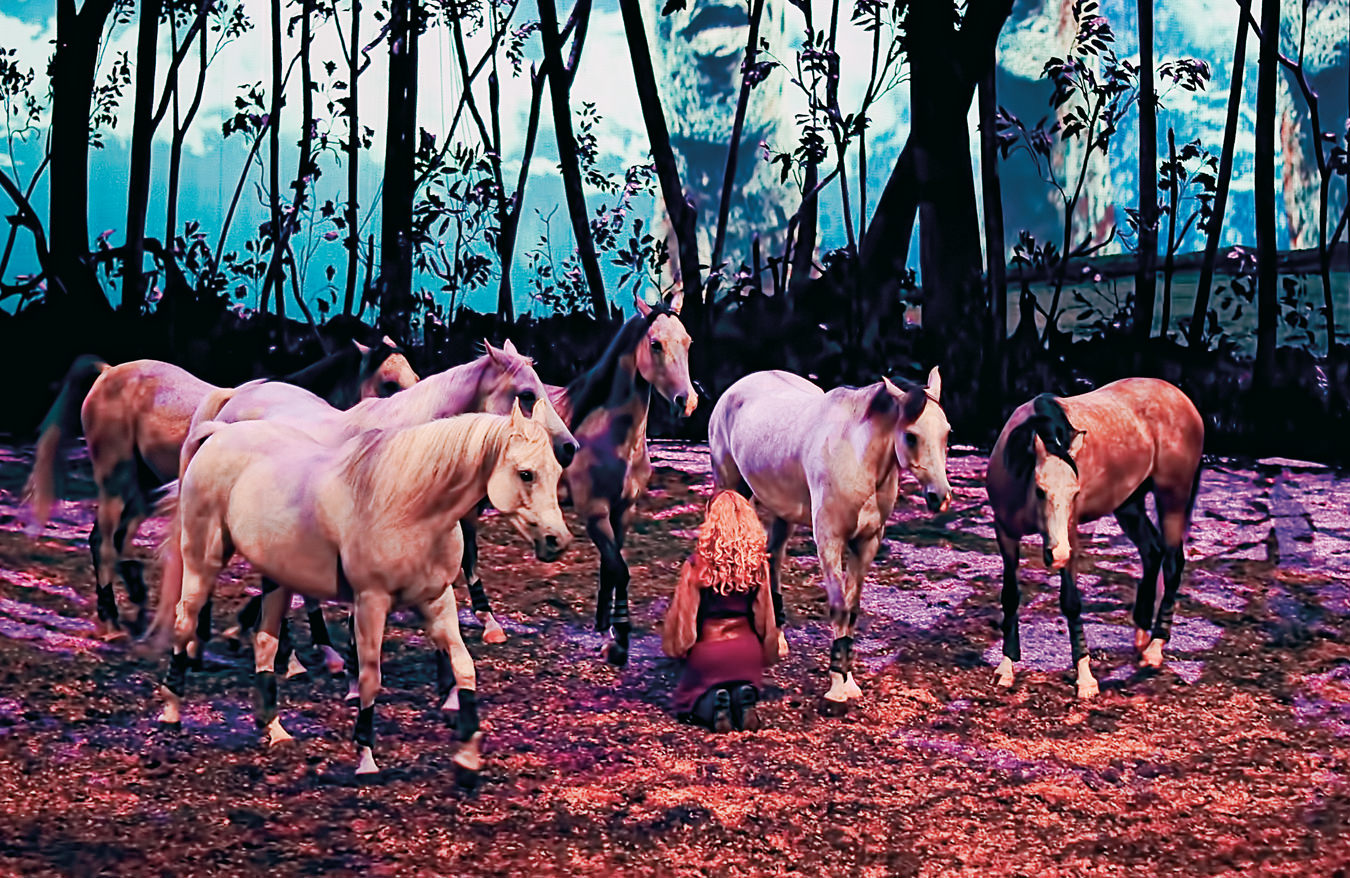
La Sédentaire, where Arabian horses encircle Elise Verdoncq, a horse whisperer. Photo by Color-ish Company.
Latourelle—the name means tower—has also wanted to make a difference, and to that end he has devoted his life. If not born motivated, the circumstances of his upbringing led him early on to be a man of action, a doer who is also a leader working tirelessly behind the scenes. One of four children born to a stay-at-home mother (at 91, Lucille is still Latourelle’s biggest fan) and a bureaucrat father who has since passed away, Latourelle grew up in the Montreal suburb of Laval in a modest household valuing hard work. There were few indulgences. His dad bought his first car when he was 42 years old. “He worked to support his family,” says Latourelle. That family consisted of two daughters in addition to two sons, the oldest born with cerebral palsy. Having an older brother with a disability had a huge impact on Latourelle as he was growing up. “I always thought ‘I have to do twice as much,’ ” he says, “I have to do for my brother what he can’t do for himself, plus do for myself.”
Staging big and bold performance spectacles is a speciality of Normand Latourelle. The Cavalia founder’s current feat: the equestrian extravaganza of Odysseo.
Driven from a young age, Latourelle found escape in Walt Disney’s Wonderful World of Color (or Le Monde Merveilleux de Disney as Latourelle knew it in French Canada), which he watched on the family’s black-and-white TV set every Sunday night. Today, more than 50 years later, Latourelle thrills at the memory of those animated shows. He calls Walt Disney his hero, the person he most wants to emulate in presenting his own shows to a theatre-going public. “He just wanted to bring beauty to this world,” Latourelle says. “He didn’t want to change the world. He’s my role model.”
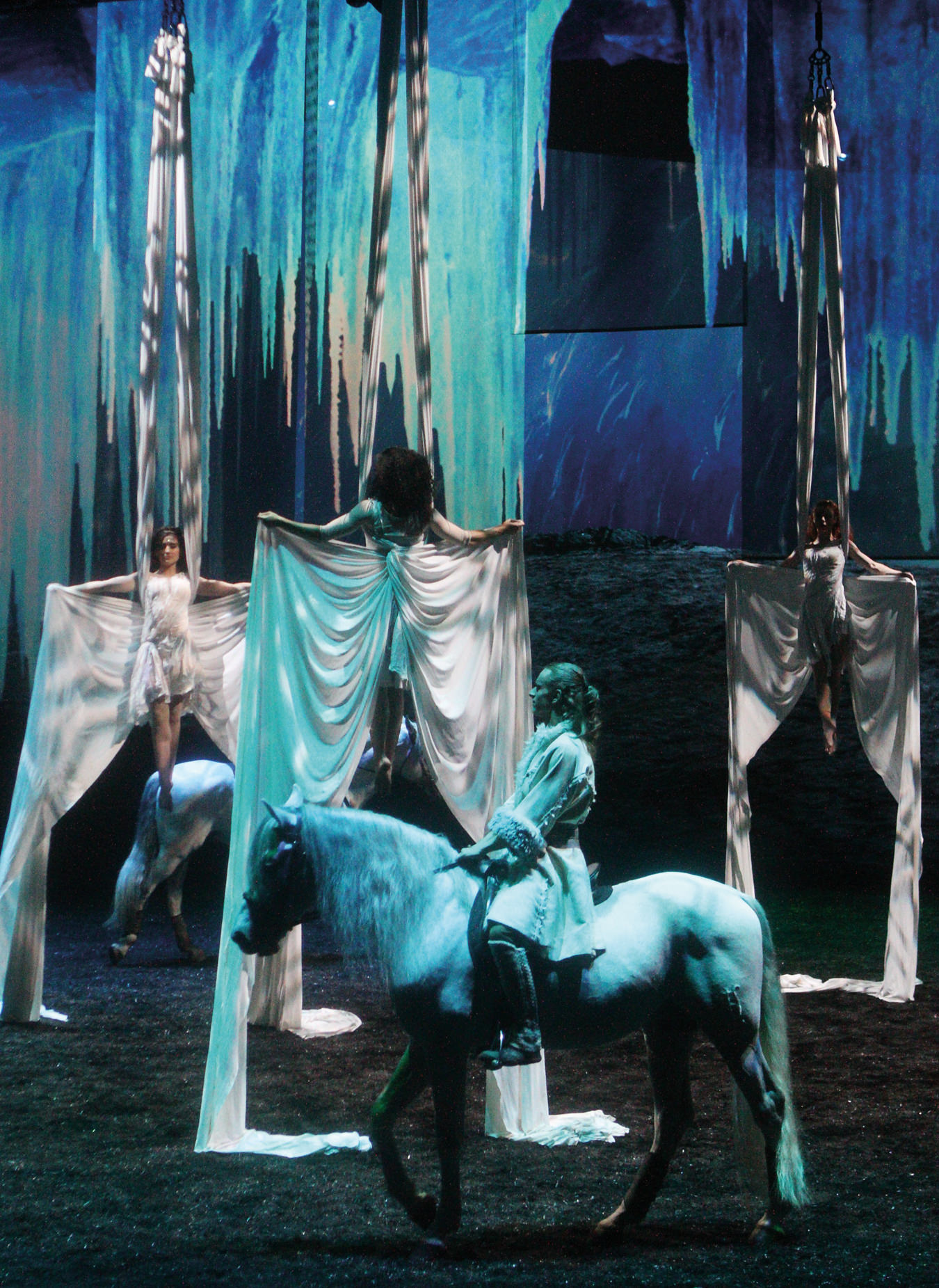
Scenes from Odysseo include Les Anges, where performers levitate over white horses. Photo by Pascal Ratthé.
Latourelle, on the other hand, has wanted to change the world. The urge manifested itself early, when Latourelle was just a boy in the fifth grade, leading a student protest to draw attention to crowded conditions at his school. He urged the students to stage a strike, an act that got him promptly expelled. Eventually reinstated, he went on to join his high school newspaper and radio station to communicate a deepening distrust of authority. “I had the power,” he reminisces with a soft smile on his face. “I had the communication tools right in my hands.”
A born-to-it iconoclast, Latourelle had been a separatist in his youth (he has since abandoned the cause) who wanted to preserve and nurture Quebec language and culture. It’s what led him to enter the vibrant world of Quebec show business in the first place. “I was always the one staging the school play, or organizing the orchestra and dance for the students,” he says. “I wanted things to change,” he continues softly. “I wanted to change the system. I thought politics was maybe for me, because I was so against authority. But then I started to express myself, and express my frustrations, through shows. I thought this is how I could change society, how I could make it evolve, through art.”
He left school at 16, taking to the road with a troupe in a van, with him behind the wheel, solidly in the driver’s seat. At 18, he was lighting dance productions for Le Groupe Nouvelle Aire, the now-legendary Quebec dance troupe (its members included Édouard Lock, Louise Lecavalier, and Paul-André Fortier, among other greats of contemporary Canadian dance). There, he met his first wife, the dancer Danielle Tardif, who would become the mother of his two sons. By 20, Latourelle was running a large, open-air performance venue in Old Montreal, attached to the historic Nelson Hotel, where traditional Quebecois music and song nightly drew thousands to join in on the entertainment. Latourelle next moved to Quebec City, where a chance encounter led him to join forces with Guy Laliberté, whose Cirque du Soleil he helped to develop. As Latourelle tells it, Laliberté had the puppets, but he had the know-how. He knew how to turn Cirque du Soleil into a compelling form of popular entertainment—and today, the Cirque brand is wildly successful, beloved around the world. But there were artistic differences, and they became insurmountable when Latourelle came to a major fork in the road where his personal life was concerned.
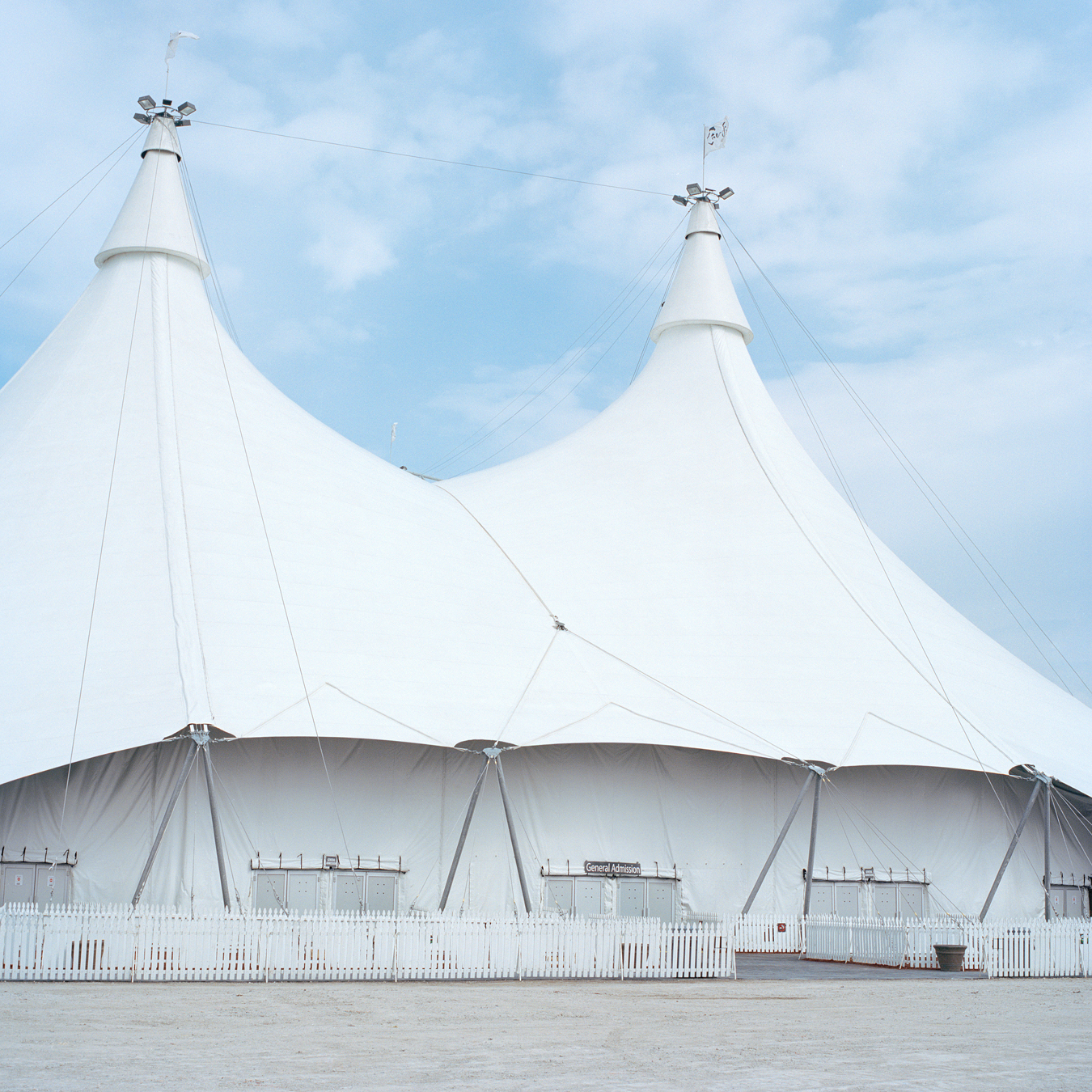
The 38-metre-tall big top’s peaked design was conceived with a carousel in mind. Photo by Hudson Hayden.
Then 29, he was newly divorced. His wife was still performing with companies like Carbone 14 in Quebec and Desrosiers Dance Theatre in Toronto. He took it upon himself to raise their children, a decision he does not regret. His sons, he says, are his biggest success in life, as well as his best friends and business partners. Today, Mathieu Latourelle is tour director of Cavalia while brother David Tardif-Latourelle is the family-run company’s vice-president of legal affairs, and the father of three kids himself. “If I had continued travelling, I would have lost them. I did not want to do that,” Latourelle explains. “I had to take care of them, so I had to tear myself away from Cirque.” While raising his kids, Latourelle focused more on his own theatrical projects. Among them was a history pageant the City of Quebec commissioned him to make to commemorate the 450th anniversary of its founding. Légendes fantastiques, staged in Drummondville in 1984, included a scene about the birth of the city that involved the public. It included more than 100 players, and one horse. “As soon as the horse came on, no one could look at anything else. It was crazy,” remarks Latourelle, marvelling at the memory. “Then someone told me to get rid of this horse. But I thought the opposite. I wanted to get more horses. I should make a whole show around them.”
From this, Cavalia was born. But it was not an easy birth. At the time, Latourelle knew nothing about horses. His ignorance led him to embark on a long journey of research, learning everything he could about the hooved beasts and humankind’s relationship to them over millennia. Latourelle shared his new-found knowledge with the new woman in his life, business partner Dominique Day (they separated last year after 22 years together), infecting her with a serious case of equine fever. To please her, Latourelle bought horses to keep at their shared farm in Sutton, Quebec. She rode while he watched from the comfort of his kitchen window. “I work with horses but I don’t ride,” he says, unapologetically. He now owns more than 60 horses of various breeds and is involved in a charity that matches retired horses with good homes. Call it an arm’s length love affair. “I love to watch them run and be horses,” says Latourelle. “They represent freedom to me.”
Odysseo “is not a simple show, but the message is simple to read. You don’t have to think too deeply about the story. You just have to let yourself go.”
Augmenting the sense of freedom is Guillaume Lord’s set design, which resembles a large open field with a rolling hill and a wide open sky that fills with birds, stars, and monolithic images from Easter Island. Horses run through it as do humans, among them acrobats and dancers from Guinea whose prowess matches that of the riders who flip, vault, hang, and drag their bodies across the stage while tethered to galloping steeds. Odysseo’s director and choreographer Wayne Fowkes created the daredevil movement sequences in association with equestrian choreographer Benjamin Aillaud and dance choreographer Darren Charles. Their horse ballet combines steps borrowed from the competitive world of dressage with the syncopated rhythms of African dance. Alain Lortie’s atmospheric lighting design in tandem with composer Michel Cusson’s original score, featuring undulating vocals in a variety of Latinesque languages, lends the performance an emotive quality that elevates Odysseo into the stratosphere of art.
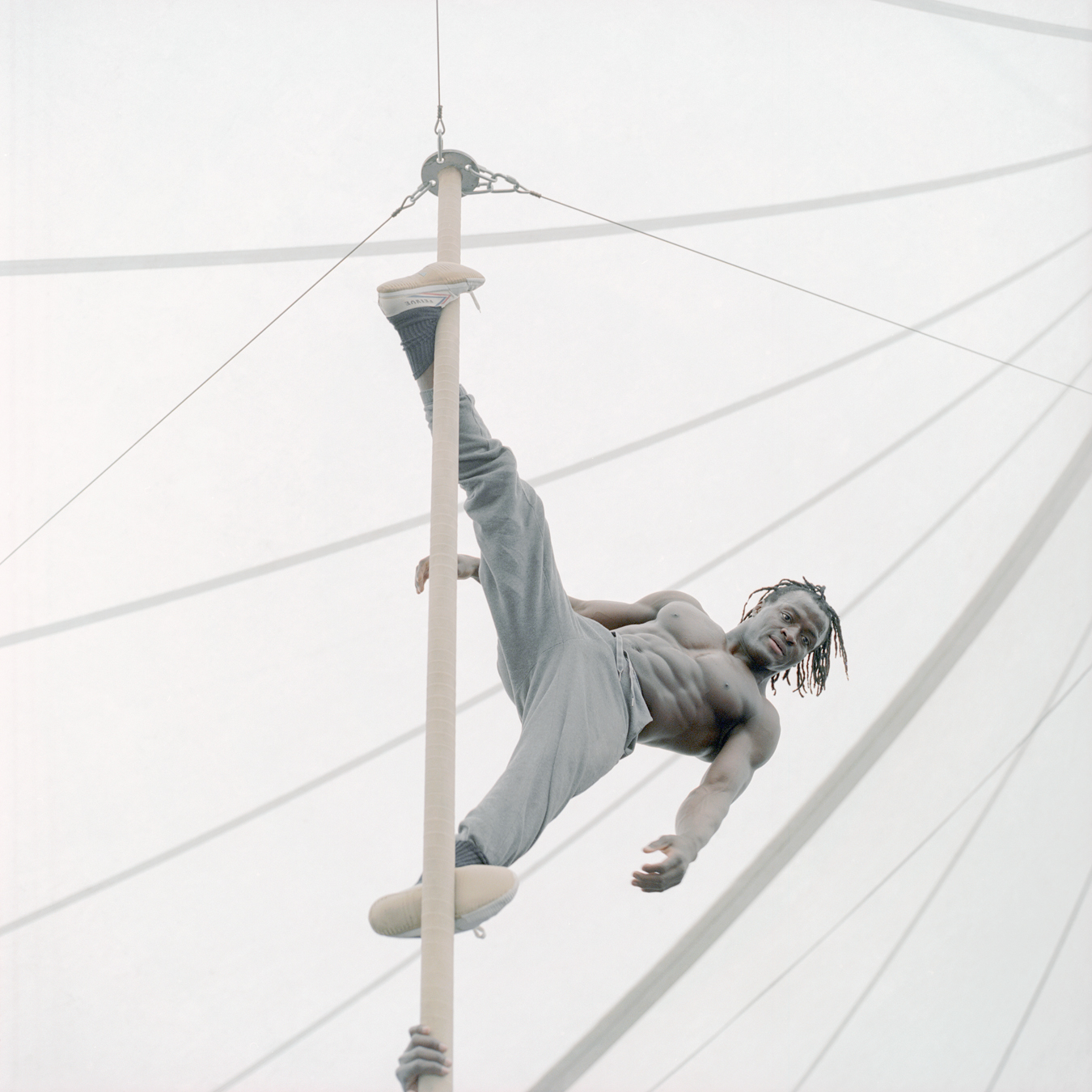
The production includes more than 45 skilled performers. Photo by Hudson Hayden.
In creating Odysseo, Latourelle vowed to preserve unbridled energy in a show that took him close to a decade to develop. He also determined to include the one true, yet significantly artificial, experience of horses he had as a child riding the carousel manned by his grandfather in Belmont Park, a now-closed amusement park located in Cartierville, a northern neighbourhood of Montreal. Latourelle was besotted with one wooden horse in particular and believed it was his horse until one day some older boys, pushing him to the side as they rushed to ride the carousel themselves, let him know otherwise.
That early relationship with a make-believe steed inspired Latourelle to also include a carousel in Odysseo. It remains hidden for most of the show, deep inside the upper recesses of a 38-metre-tall big top whose peaked design, a feat of mechanical engineering, was conceived with the carousel in mind. “The shape and height of the tents are dictated by the shape of the merry-go-round,” says Latourelle. “I wanted it to be hidden before it comes down, so it surprises.” The increased height means that Odysseo is heavier than most touring shows. “Usually the [specifications] for an arena of this size allow for a maximum weight of 50 tons. But this show is 80 tons, which is more than any touring rock and roll show,” Latourelle explains. What this means is that Odysseo is as innovative technically as it is artistically. Besides an 18-ton merry-go-round, the show has 18 high-definition projectors, 10,000 tons of sand mixed with fibre on the stage floor, and an underground system that floods the playing area with over 300,000 litres of water. Latourelle calls Odysseo the world’s first 6-D show. But the best description comes from James Cameron, the director of Avatar, who told Latourelle that his horse spectacle represented the future. “Excuse me? James Cameron is telling me I am the future,” says Latourelle with dramatic flourish. “I asked him to explain himself, and he said that so much of what we as the movie industry know is made by computer and is artificial. But this show is true. It happens before your eyes. It shows the bond between animals and people, and it’s real. It’s not a gimmick.”
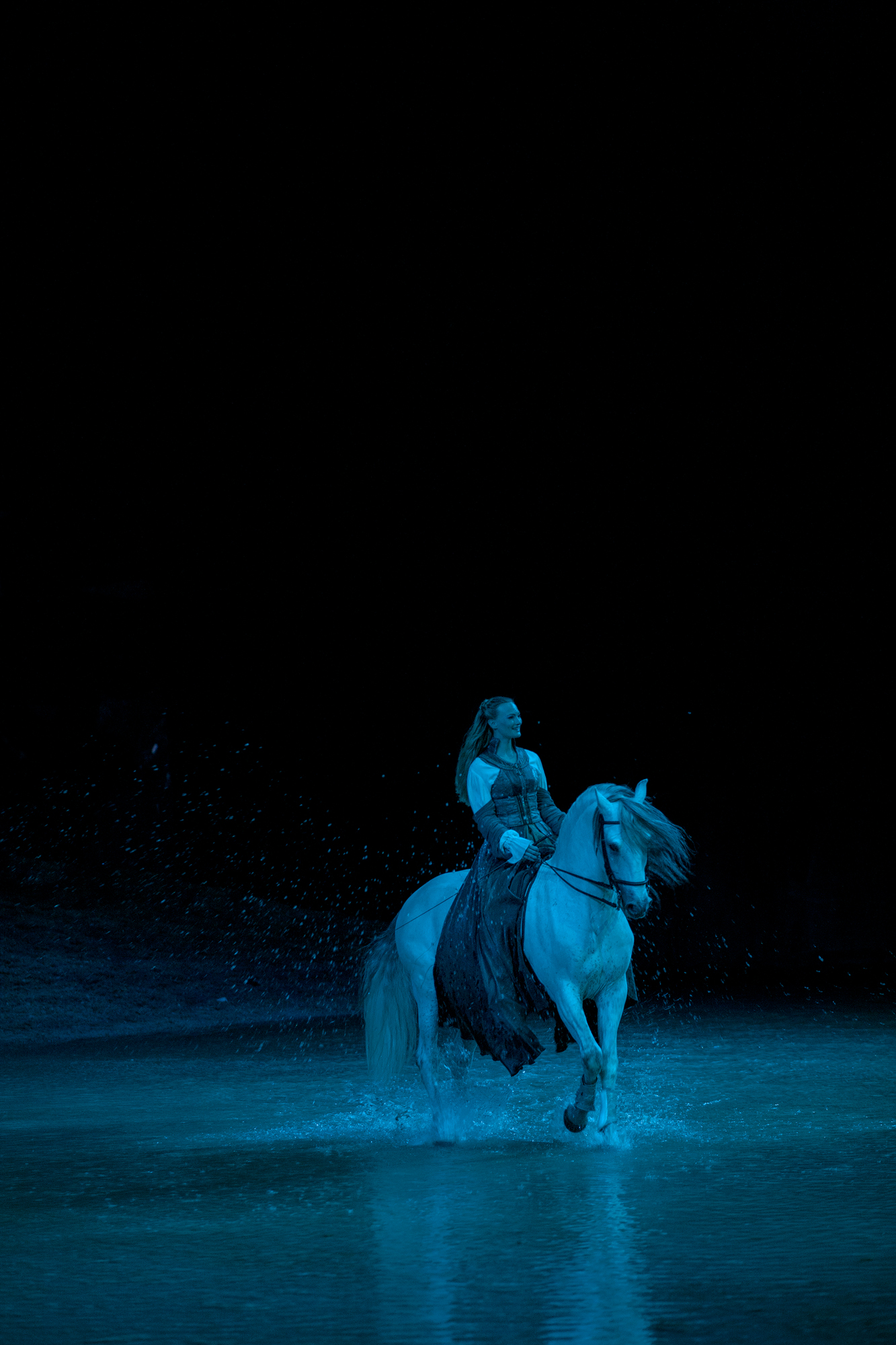
An underground system floods the playing area with over 300,000 litres of water. Photo by Hudson Hayden.
Making that bond come to life on the stage, even if that stage is meant to resemble an open field, requires a lot of trust, patience, and oats imported from Latourelle’s home province. The horses always eat grains harvested in Quebec. It’s a regular part of their diet, and eating it makes them feel at home wherever they go, says Latourelle. The special treatment is deserving of their star status within the show. When not crunching on oats, the horses get regular deep tissue massage and scented showers, during which their long, flowing tails and manes are washed with equine shampoos. Afterward, they are dried, brushed, and braided; they are put in clean stalls with horses they like as their next-door neighbours. They get daily exercise in the ring and are allowed to run free during the day in an outdoor paddock. These horses are well cared for. Only male horses are used in the show, a combination of stallions and geldings, and their average age is nine. The absence of sex and female horses is intended to keep the horses calm and happy. But this is not to say Odysseo is monastic. Far from it. Back in the lunch tent, Latourelle is explaining the facts of life, and it goes like this. The animals in Odysseo don’t breed, but the people do. “It’s the only reason why someone ever leaves. They get pregnant,” he says. “We have a lot of Cavalia babies.” And you can bet that Mayor Latourelle kisses them all.

